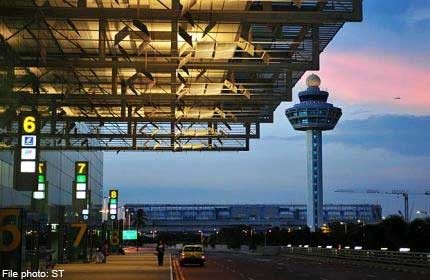Time to connect the air dots

SINGAPORE - Changi Airport's closest neighbours are growing, backed by two of Asia's most aggressive low-cost carriers. Down south, Indonesian airline Lion Air has rolled out ambitious plans for Batam's Hang Nadim Airport.
Up north, Malaysia's AirAsia is boosting flights to Senai Airport in Johor Baru.
Both airlines fly direct to Singapore and want to add services at Changi Airport, but are being held back either because they can't get their preferred flight times or air rights to mount more flights.
To get around this, AirAsia has added more flights to Senai and offered free bus rides across the Causeway for Singapore-bound travellers. The airline now flies to 10 domestic points within Malaysia and three international destinations from the Johor airport. It plans to boost capacity.
Lion Air has a similar strategy in Batam. It currently links the airport to 13 domestic points in Indonesia and aims to go international next year. The airline is also planning its own ferry service between the island and Singapore.
Should Changi feel threatened by Hang Nadim and Senai, when it handled 51 million passengers last year, dwarfing the upstarts' respective traffic of about six million and two million passengers?
It's unlikely the folks at Changi are losing sleep over this, though they are no doubt watching developments closely.
Both Lion Air and AirAsia have huge plane orders - more than 450 each. Where they choose to park those planes could affect Changi Airport in the long term. But this does not necessarily have to be in a bad way.
There is good potential for Changi to collaborate with its two closest neighbours.
Assistant Professor Terence Fan from the Lee Kong Chian School of Business at Singapore Management University said: "Changi-Singapore can benefit from the increase in volume and the likelihood of passengers originating from or travelling to Johor Baru or Batam, using Changi as their transit point."
Associate Professor Michael Li from Nanyang Technological University's Business School added: "It is always a good idea for a major airport to work closely with regional airports on the fringe because of the network nature of the airport business... It is in Changi Airport's best interest to nurture long-term collaborations with Senai and Hang Nadim."
The Asia-Pacific is slated to become the largest air travel market in the world, with strong potential in markets such as China, India and Indonesia.
Changi Airport is adding both terminal and runway capacity to cater for the growth, with plans for a third runway by the end of 2020 and a new mega passenger terminal to be ready in the middle of the next decade.
Still, there will always be a limit to the number of flights it can handle. Working with the airports in Batam and Senai and the airlines that fly there, Changi and Singapore can share some of the gains from their growth.
Singapore has always supported closer ties with its two neighbours. A growth triangle to boost economic cooperation between Singapore, Malaysia and the Riau islands was mooted in 1989 and has borne fruit.
In January last year, Singapore and Malaysia proposed a tie-up between Changi and Senai airports to boost relations, after the two prime ministers met.
It's time for both parties to work on actual plans to turn that into reality. One way to start is to make cross-border transfers more convenient.
Hong Kong International Airport for example works with selected airlines to offer a ferry service for travellers from Macau and seven other ports in the Pearl River Delta. Check-in and baggage facilities are offered at the ferry terminals so there is no need for travellers to check in again when they get to the airport.
Associate Professor Fan suggested that travellers from Batam and Senai airports connecting to flights from Changi can be escorted in special buses direct to the border checkpoints "to eliminate hassle".
For added convenience, travellers have suggested dedicated immigration lanes to cut overall travel time.
Plans for a high-speed rail between Kuala Lumpur and Singapore and possibly, a Singapore-Johor Baru MRT link, will make transfers even more convenient in future, especially if the trains stop at Senai and Changi.
Close collaboration will benefit all.
With Jakarta's airport bursting at its seams, Batam's Hang Nadim could become an alternative transit point for travellers from Indonesian cities heading to Singapore's Changi Airport for connecting flights.
Senai can also be an attractive option for Malaysia residents who wish to fly from Changi. This need not be at the expense of Kuala Lumpur International Airport given the potential air traffic growth in Asia, which can maintain several air hubs.
With Asia's air travel business flying high, the time is ripe to connect the dots of the Changi-Senai-Hang Nadim triangle. Working across national boundaries will not be without turbulence but the pay-off for travellers, airports and airlines will be huge.
karam@sph.com.sg

Get a copy of The Straits Times or go to straitstimes.com for more stories.